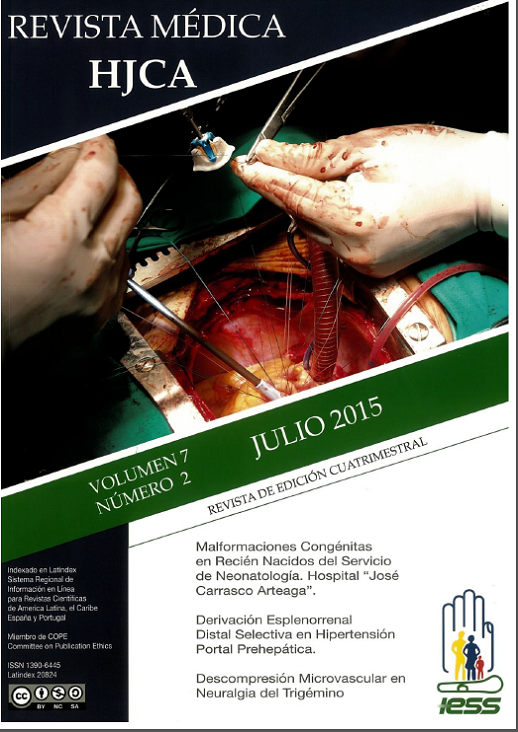Estudio Descriptivo: Gardnerella Vaginalis en Pacientes con Vaginosis Bacteriana que Acuden a la Consulta Ginecológica del Hospital “Aida León de Rodríguez Lara”. Girón, 2014
Palabras clave:
GARDNERELLA VAGINALIS, VAGINOSIS BACTERIANA, PREVALENCIA, DIAGNÓSTICOResumen
INTRODUCCIÓN: La vaginosis bacteriana (VB) es una infección muy frecuente en las mujeres en edad reproductiva, el problema a investigar se fundamenta en la falta de un diagnóstico definitivo. En el Hospital de Girón el tratamiento se basa en esquemas clínicos, por lo que se desconoce la frecuencia real de gardnerella vaginalis (GV). El objetivo del presente estudio fue el determinar la presencia de Gardnerella vaginalis como agente causal de vaginosis bacteriana en las pacientes que acudieron a la consulta ginecológica en el Hospital de Girón, provincia del Azuay - Ecuador, durante el período enero-junio 2014.
MÉTODO: El presente es un estudio observacional descriptivo, realizado en una población de mujeres con diagnóstico clínico de vaginosis bacteriana. Se realizó la identificación de la gardnerella vaginalis por cultivo utilizando el agar HBT (Human Blood Tween) por sus siglas en inglés, que contiene una capa inferior de agar colistina-ácido nalidíxico con suplemento de peptonaproteasa, anfotericina B y Tween 80 al 0.0075% que mejora el crecimiento y aumenta la beta hemólisis y, se recubre con una capa superior de la misma composición agregando sangre humana al 5%.
RESULTADOS: Se practicaron 148 procedimientos para el análisis de muestras de secreción vaginal; se aisló gardnerella vaginalis en el 29.1% de los casos. En el 70.9% a pesar de la clínica de VB los resultados fueron negativos para GV; la frecuencia en mujeres embarazadas fue del 21.6% y de éstas, el 43.8% cursaban el segundo trimestre de gestación. La mayor prevalencia estuvo entre los 20 y 29 años con un 28.10%, se evidenció una relación estadísticamente significativa entre la edad y la frecuencia de infección por GV (p<0.05).
CONCLUSIÓN: La prevalencia de identificación de GV en la presente muestra fue menor a la reportada internacionalmente.
*DESCRIPTORES DeCS: , , , .
ABSTRACT
Descriptive Research: Gardnerella Vaginalis in Patients with Bacterial Vaginosis Who Attended
to Gynecology and Obstetrics Consult of “Aida León de Rodriguez Lara” hospital. Girón, 2014.
BACKGROUND: Bacterial vaginosis (BV) is a very common infection that affects women of reproductive
age, the research is based on the lack of a definitive diagnosis. The treatment at Giron’s hospital
is based on clinical schemes, so the actual frequency of Gardnerella vaginalis infection (GV) is unknown.
The objective of this study was to determine the frecuence of Gardnerella Vaginalis as a cause
of bacterial vaginosis in patients that attended to mentioned hospital from January to June of 2014.
METHOD: This is a observacional- descriptive study performed in a population of women with a
clinical diagnosis of bacterial vaginosis. The identification of GV was made by cultivation using HBT
(Human Blood Tween) agar, containing a bottom layer of colistin-nalidixic acid agar supplemented
with peptonaproteases, amphotericin B and a 0.0075% diluted Tween 80 solution that improves
growth and increases beta hemolysis and lasts with the coat with a top layer of the same composition
and adding 5% human blood .
RESULTS: 148 procedures to analyze samples of vaginal secretion were performed; Gardnerella Vaginalis
was isolated in 29.1% of cases. In despite that 70.9% of VB clinical diagnosis were negative
for GV, the rate of pregnant women with a positive test was 21.6% and 43.8% of them were coursing
the second trimester of pregnancy. The higher frequency was between 20 and 29-years representing
a 28.10%. Age and frequency of infection by GV demonstrated statistical significance and association(
p<0.05).
CONCLUSION: Prevalence of Gardnerella Vaginalis identification was lower than reported internationally
in the studied population
KEYWORDS: GARDNERELLA VAGINALIS, BACTERIAL VAGINOSIS, PREVALENCE, DIAGNOSIS

